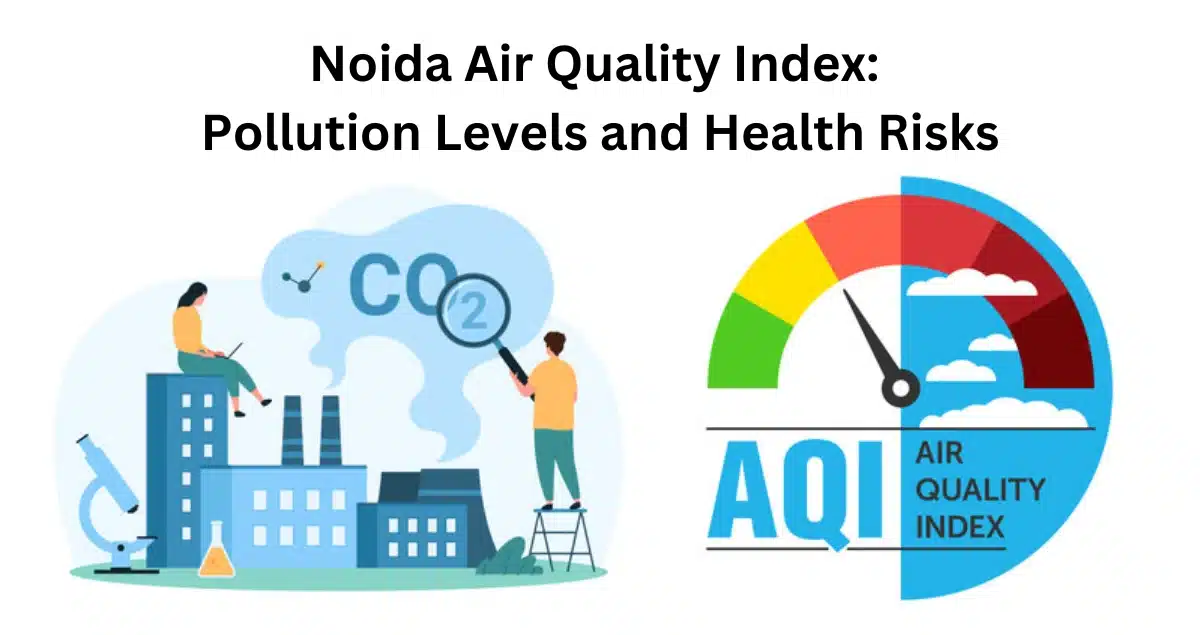Noida is one of the rapidly growing cities of National Capital Region (NCR) of India that has seen a progressive change over the last decade. However, this growth has made the air around us unhealthier in this regard which is not right. People in Noida and the local authorities have expressed concerns over the Noida Air Quality Index (AQI) numerous times. In this post, the given focus of discussion is the improving air quality situation in Noida, Greater Noida, and their specialty industries, as well as on the guidance concerning effective air quality management in the region.
What is the definition of Air Quality Index (AQI)?
The Air Quality Index (AQI) is a measurement of what the level of air quality is in a given region or a single number that shows the quality of the air. It goes up to 500, and the higher the value, the worse the air being offered is.
- AQI has subcategories from Good Air Quality (AQI 0 -50)
- Moderate Air Quality (AQI 0-50)
- Unhealthy: Breezy Polluted (AQI Greater than 200 up to 300)
- Extremely Poor or Dangerous Air Quality (AQI 301 – 500)
The AQI depends on the concentration of seven pollutants:
- Particulate Matter (PM2.5 and PM10)
- Nitrogen Dioxide (NO2),
- Sulfur Dioxide (SO2),
- Carbon Monoxide (CO),
- Ozone (O3)
Air Quality Index in Noida
The index of air quality in Noida varies from one season to another with the worst situation being recorded during the winter season when the AQI become officially ‘unhealthy’.
Key Factors Contributing to High AQI in Noida:
- Vehicular emissions (high vehicle density)
- Construction activities (dust and pollutants)
- Industrial pollution (nearby industries)
Such pollutants draw a danger to the lives of residents, especially those with respiratory problems, since they pose a major threat to the respiratory system.
AQI Throughout the Year:
Winter (November – January):
- High AQI levels, often reaching 300-500 (Hazardous).
- Impact due to farm fires in nearby states like Punjab, Haryana and pollution caused by fire crackers on Diwali.
- PM2.5 levels spike during this period.
Summer (March – June):
- Moderate AQI levels ranging from 100-150 (Unhealthy for Sensitive Groups).
- Little amount of stubble burning compared to the previous years but affected by traffic and industrial emission.
Monsoon (July – September):
- This would mean better AQI usually ranging from 50-100 (Moderate).
- Rain becomes cleaner after rain from pollutants produced through various human activities.
Autumn (October):
- There was a gradual rise in AQI for instance in the 100-150 mark due to changes in weather and pollution from vehicle emissions as well as construction activities.
Noida Sector 137: AQI
Noida Sector 137 Overview:
- Sector 137 in Noida is a large region that includes both residential apartments and commercial buildings.
AQI Challenges in Noida Sector 137:
- Data analysis of AQI in Sector 137 discloses that it often gets classified under high levels of Air Quality Index.
- Noise pollution, dust pollution – construction activities and emissions from the industries in the neighborhood also affect air quality.
Factors Affecting Air Quality:
- Dust and particulate matter from ongoing construction work.
- Industrial pollution from nearby factories and commercial zones.
- Vehicular emissions due to heavy traffic in the area.
Health Implications:
- AQI levels are higher and have adverse health effects on patients with respiratory diseases and societal vulnerable populations.
Residents’ Precautions:
- Most residents in Sector 137 have also been able to install air purifiers in their houses.
- The use of masks is not only popular but compulsory while in outdoor activities with an aim of shielding ourselves from pollution.
Air Quality Index Noida Sector 76 and Sector 62
Noida Sector 76 AQI:
- Sector 76 had higher AQI values within the moderate to high range and were higher during rush hours.
- Emission of vehicular fumes from the highly crowded roads
- Air pollution comes from dust which may be acquired from under construction structures.
- It ranges from 100-150 in this area, which is considered unhealthy particularly for the sensitive category.
Noida Sector 62 AQI:
- Commercial, industrial and residential buildings are located on sector 62 that largely determine the AQI.
- Industrial emissions and vehicular pollution are the primary sources of high AQI levels.
- This index in this sector has been found to be moderately to unhealthy that varies from 150-200 in the sectors especially during the winter.
Common Pollutants:
- Both sectors exposed to high levels PM2.5 and PM10 due to construction and traffic.
- Other pollutants which contribute to this include nitrogen dioxide (NO2) from vehicles and carbon monoxide (CO).
Health Impacts:
- People with respiratory illness or small kids may have discomfort in their health due to the affected AQI in both sectors.
Efforts to Improve AQI:
- The local governments are targeting on regulating emissions from motor vehicle, minimizing construction dusts and enhancing greens spaces in the areas.
Air Quality Index Greater Noida: Challenges and Solutions
The city of Greater Noida has been undergoing urbanization and many residential and commercial projects are coming up here. But at times, the Greater Noida Air Quality Index has raised eyebrows. In regions with high traffic congestion the AQI is shown to increase significantly, particularly during the winter season, around commercial and main transport zones. They have been trying to regulate air quality by such programs as those intended to minimize emissions from automobiles and enhance green areas, among others; however, problems persist.
Ways to Improve Air Quality in Noida
Thus, National Capital Territory of India (NCT) Noida must develop strategies to increase air quality The following are some of the ways through which air quality in Noida can be improved:
Reducing Vehicular Emissions:
- One of the most effective ways to improve the AQI in Noida and Greater Noida is by reducing vehicular emissions. We also need to try and engage in car pooling as much as we can.
- When used together with electric vehicles, this can go along way in reducing the amount of pollution in the environment.
Increasing Green Spaces:
- This deem that there is need to develop more parks, gardens, green belts because these can help to filter pollutant on the environment and produce fresh air.
- The local authorities should strive to increase the coverage of the green area within residential and the commerce regions.
Strict Construction Guidelines:
- Ensure strict guidelines for construction activities from emitting harmful gases. This way you can ensure that the quality of air remains better, especially in areas such as Noida Extension and Sector 137.
Awareness and Education:
- People of a particular area should be informed of their environment and ways they can save themselves.
- You can use indoor air purifiers, start wearing masks, and limit outdoor activities on high AQI days can help reduce health risks.
Conclusion
The Noida Air Quality Index is still remained a severe problem for the residents of Noida and other sectors including Noida Sector 137, Sector 62 and Greater Noida. Due to population growth and more so the shifting of people from rurally to urban areas, rapid industrialization, there has been a lot of pressure on the environment. But, only the strict compliance of principles by the government and the public, the air quality of a country can be enhanced. We have a separate blog post for Delhi and Bangalore AQI .
Noida is also capable of functioning towards becoming a cleaner healthier city through adoption of certain policies such as sustainable practices, enhancing green areas and controlling emissions. Keep abreast with the current AQI so as to know when to protect yourself or when the air quality is safe for your family.
FAQs
However, Noida cannot be considered absolutely free from pollution. This happens due to large numbers of industries along with vehicular emissions, construction work, and sometimes due to seasonal factors such as crop burning in neighbouring regions.
Yes, AQI levels may be different in different part of Noida. For example, Sector-1 and Sector-125 have monitoring stations so that the data was obtained in real-time, the pollution levels could be different.
The main pollutants are Particulate Matter- [PM2.5 and PM 10], Nitrogen dioxide [ NO₂], Sulfur dioxide [SO₂], Carbon monoxide [CO] and Ozone [O₃].

